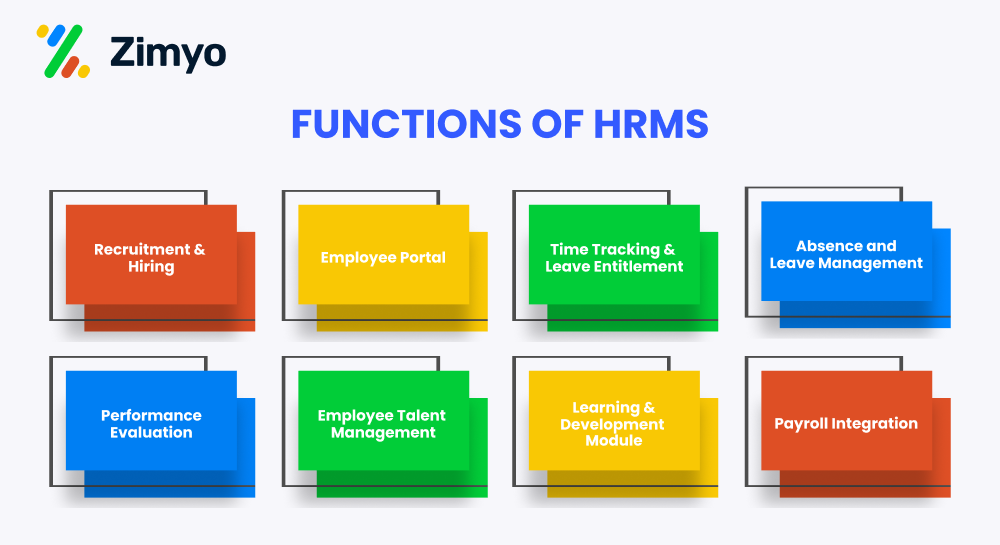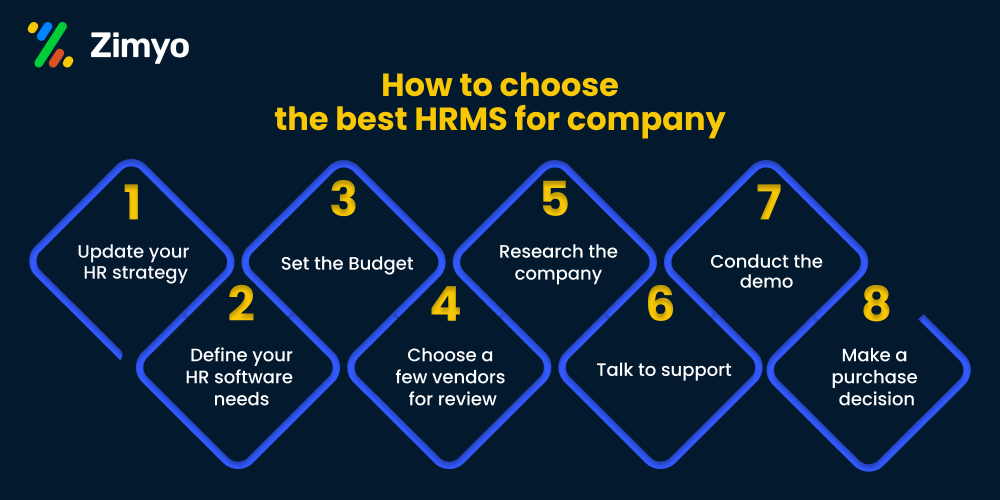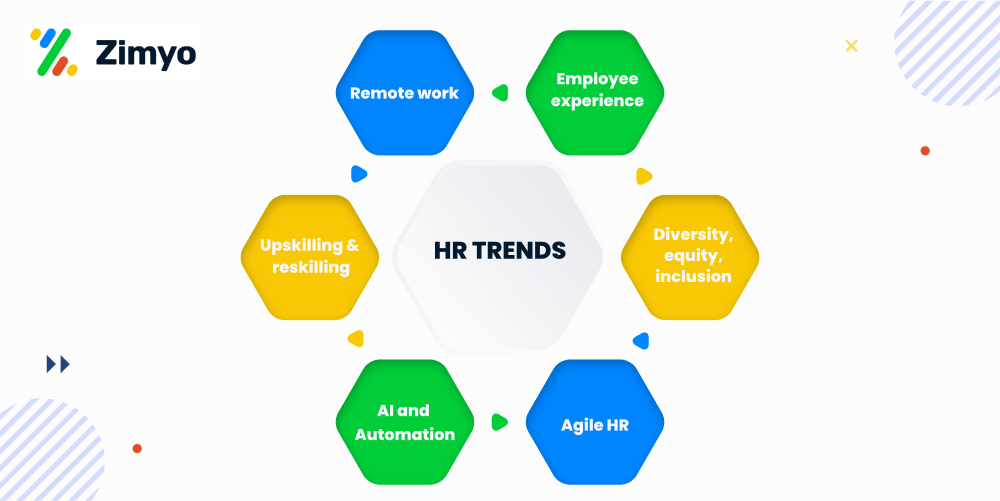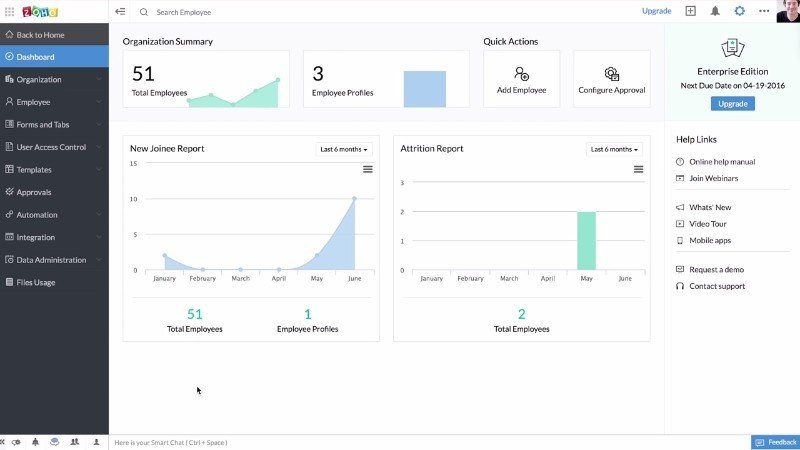The business world operates at a breakneck speed, and you must manage your resources efficiently to keep up. This is where HRMS comes in.
HRMS is a one-stop solution that automates HR processes and enables organizations to manage their workforce efficiently and effectively.
HR functions, such as recruitment, onboarding, payroll processing, benefits administration, performance management, and training and development, are integrated into a single platform. This simplifies the process and makes it more efficient. This frees up the bandwidth of HR and management, allowing them to focus on more critical tasks.
This HRMS guide aims to cover its key features, benefits, implementation, and best practices. In the following sections, we will explore the various modules of HRMS and how they can benefit organizations. We will discuss the different types of HRMS solutions.
We will also look at factors to consider when selecting an HRMS for your organization.
Whether you are a small business owner or an HR professional in a large enterprise, this HRMS guide will help you understand the importance of HRMS and how it can help you manage your workforce more effectively. Let’s dive into the world of HRMS!
HRIS (Human Resource Information System) is a software application that manages employee data required to perform core HR functions, including payroll and tax compliance, attendance tracking, benefits administration, personnel tracking, and self-service.
HRMS (Human Resource Management System) tracks employee lifecycle management processes, including performance management, recruiting, onboarding, and reporting, to help HR departments keep track of and better understand their employees’ performance.
HCM (Human Capital Management) comprises core HR functions for workforce acquisition, management, and optimization. It includes administrative functions, company data, talent management, and labor and workforce management, among other things, to maximize the business value of an organization’s employees.
The main difference between HRIS and HRMS is that HRIS provides essential functions such as payroll and attendance tracking, while HRMS offers performance management and reporting functionality. On the other hand, HCM is an umbrella term encompassing HRIS and HRMS functionality and includes additional features to drive workforce initiatives like talent optimization strategies, create attractive compensation packages, increase the ROI of human capital, and encourage business growth.
HRIS serves as a key hub for managing and storing data related to essential HR operations, including payroll, taxes, attendance, benefits, personnel information, and employee self-service.
Focuses on tracking employee lifecycle management processes, including performance management, recruiting, onboarding, and reporting.
It covers core HR functions such as workforce acquisition, workforce management, and workforce optimization.
These functions involve administrative tasks, providing access to company data, managing talent, and managing labor and workforce.

The essential features of HRMS software that businesses should consider while choosing an HRMS for their organization are:
Hiring and recruitment are essential tasks for any business. Finding the right people with the right skills can make or break completing your tasks. A recruitment module is a comprehensive HR technology solution that streamlines internal form-filling and authorization processes.
It enables managers and HR professionals to post job advertisements and supporting documentation online, providing applicant tracking and initial screening functionality. Additionally, it can help create talent pools, which can be easily searched for suitable candidates when vacancies arise.
Recruitment modules have fully integrated social media, making it easier for organizations to engage with potential candidates.
Compatibility with social media platforms like LinkedIn is becoming more common. Integrations are now a major factor when selecting software.
Nowadays, employee self-service is an essential component of any HRMS. Without it, the impact and advantages of the HRMS will be limited to the HR department and boardroom.
Employee self-service offers a variety of features. These include the ability to submit requests for paid time off. It can also include a complete HR portal with a personalized dashboard for each employee. This dashboard provides access to various HR services, from selecting benefits options to booking and attending virtual training and development programs.
Time and attendance tracking is one of the oldest automated HR functions still in use today and is often integrated with biometric identification to prevent fraudulent practices. This module can be linked directly to the workforce management module and integrated with payroll and accounting software. Features commonly found in time and attendance modules include;
The leave management module is a tool for automating the process of absence from the workplace. It is often linked to time and attendance and workforce management modules. This module can be used to allocate, book, approve, track, and monitor any absence.
The module should streamline request and approval processes and update the team’s calendar accordingly.
Standard features of the absence and leave management module include;
The performance management module automates the appraisal process, allowing for the recording and tracking of objectives and targets. It should include your organization’s competence framework, job standards, and other relevant systems.
Standard features of this module provides features such as;
The talent management module is designed to help identify employees with potential and establish pipelines to prevent critical skill and experience shortages that could impact organizational performance.
Talent management modules should be able to effortlessly connect with recruitment, education and development, and performance management components. Characteristics of these modules typically include;
The learning and development module is designed to support employee growth and development. It typically uses the results of the performance management process to create individualized training plans and manage bookings for various learning opportunities.It is responsible for monitoring the post-training assessment and giving feedback, as well as keeping track of how much was spent on training in relation to the allocated budget.
Some common features of the learning and development module include the following;
The payroll function is an essential aspect of any organization, and the traditional method of managing payroll involves a separate software system.
However, with the increasing trend of bundling payroll functionality into HRMS systems, there are several benefits to using this integrated approach. One key advantage is the ability to utilize employee data already stored in the HRMS system for payroll calculations, including personal identification, banking details, and hours worked.
Additionally, HRMS-based payroll offers enhanced data security, accuracy, and legislative compliance, with a reduced likelihood of errors. Another significant benefit is the accessibility of all people-related automation via a single portal or access point.
With an efficient Payroll management system, all payroll activities can be managed smoothly, including compensation, rewards, bonuses data, and up-to-date payroll management, and businesses can minimize data redundancy, reduce manual data entry, and enhance accuracy, ensuring the desired outcomes are achieved.

With the help of HRMS, HR operations like recruitment, onboarding, time and attendance, leave management, payroll, travel and expense management, and performance management can be centralized. This eliminates the need for separate software for each operation, making managing employee data and workflows easier from a single platform.
HRMS ensures greater accuracy in HR operations. By automating HR tasks like attendance and leave management, HRMS minimizes the scope for errors, thus enhancing employee data and calculation accuracy.
An HRMS saves HR professionals significant time by automating tasks that were earlier done manually. It streamlines HR operations, making the process faster and more efficient.
Compliance with state and central rules is critical for HR operations. An HRMS helps ensure that HR operations are always compliant by providing automated compliance checks and updates.
HRMS can be a cost-effective solution for organizations, as it eliminates the need for manual work, reduces errors, and minimizes the need for paper-based documentation.
An HRMS can help improve employee engagement by offering employees greater control over their data and personal information. With features like employee self-service portals and mobile applications, employees can access their data and fulfill their requirements independently.
HRMS provides HR professionals with comprehensive data insights into HR operations. This helps HR professionals make informed decisions and optimize workflows to enhance efficiency and productivity.

Before purchasing an HR management system, reviewing and updating your HR strategy is important. This will help you define how you want to organize your HR department and what HR goals you want to achieve. This will help you identify the specific features and functions you need in an HRMS and ensure that your chosen system aligns with your organization’s HR strategy.
Once you have a clear HR strategy, you can identify the HR tasks your software needs to fulfill. This includes tasks such as employee database management, recruitment, learning management, HR analytics, report writing, benefits administration, and employee self-service (ESS). It’s important to create a detailed list of the specific features and functions you need and ask questions for each point to clarify your requirements.
Before you can start searching for vendors, you must determine how much money you are willing to spend on an HRMS. This includes the one-time payment for software, the monthly or quarterly fee, and implementation, support, and other costs. Having a budget in mind will help you narrow down your search to HRMS vendors that fit within your price range.
Once you have defined your HR software needs and set a budget, you can browse different HRMS vendors. Selecting 4-5 vendors for review is important to avoid getting overwhelmed with too many options. Having a few reserve options is also good if some of your primary choices don’t meet your requirements.
Before setting up a demo, it’s important to research the HRMS vendor and talk to their support team. You should inquire about company policies, information security strategies, and data backup procedures. It’s also helpful to find out how long the company has been in business, as this can indicate the quality of its products and customer satisfaction.
Once you’ve narrowed your options, it’s time to demo each HRMS. It’s important to invite the people who will be using the system daily to test the software and provide feedback. During the testing process, make notes about each system’s various functions and features and evaluate their usability.
After conducting demos and analyzing each HRMS vendor, it’s time to make a purchase decision. You should get approval from management before purchasing and ensure that the HRMS you choose aligns with your HR strategy and fulfills your specific software needs.

The field of HR is ever-changing. As the workforce grows and the market changes, HR must adapt itself to future trends and react proactively.
Below, we have discussed some trends we feel will become important in the future.
(AI) and automation revolutionize HR operations. With chatbots and AI-powered systems, routine tasks such as screening resumes and scheduling interviews can be automated, freeing time for HR professionals to focus on more strategic tasks. AI can also analyze employee data, enabling HR to identify trends and make data-driven decisions.
The COVID-19 pandemic has accelerated the trend toward remote work and is expected to continue in the coming years. This shift presents a new set of challenges for HR, including managing employee engagement and productivity in a virtual environment.
The focus on employee experience is growing as companies recognize the importance of creating a positive work environment. HR is responsible for ensuring that employees feel valued and supported and meet their needs. This includes providing opportunities for growth and development, offering flexible work arrangements, and promoting work-life balance.
Diversity, equity, and inclusion (DEI), have become a top priority for many organizations. HR is critical in creating a diverse and inclusive workplace by implementing policies and programs that promote diversity and address bias and discrimination.
Agile HR is a flexible, responsive approach that allows HR to adapt quickly to changing business needs. This involves breaking down silos, promoting collaboration across different departments, and adopting an iterative approach to HR processes and programs.
As technology advances, the skills required in the workforce are evolving. HR must take a proactive approach to upskilling and reskilling employees to ensure they have the necessary skills to succeed.
This part will discuss the top three HRMS software available in the market and how Zimyo HRMS stands out among them.
Zimyo HRMS is a cloud-based software that provides a comprehensive suite of services to manage an organization’s HR functions.
It offers over 40 modules, including HR and Payroll Management, Time and Attendance Management, Performance Management System, Applicant Tracking System, Employee Engagement, and additional Employee Benefits. Zimyo’s
G2, a global review platform, has recognized Zimyo as the top HR software provider in the APAC region. The HRMS software can be tailored to meet the specific requirements of any organization, large or small, and features an interactive dashboard, error-free calculations, and multiple HR functions. The pricing is based on the number of employees and starts at Rs. 60/- per employee per month, with flexible payment options available.
Along the years, the HRMS platform has onboarded elite clients such as Yash Raj Films, Bajaj Capital, Amity University Online, CollegeDekho.com, TVF, Burger Singh, 88 Pictures, etc., among many other renowned names.
Zimyo HRMS aims to keep rising and now with its presence in the GCC region as well, its moving forward to make its presence known in other countries around the world. Zimyo is making the employee experience a quality one for every employee worldwide.

Freshteam HRMS is an ideal solution for workforce management in growing businesses. It allows HR professionals to attract, hire, and onboard new hires without any hassles.
The software simplifies complex HR processes and helps manage offboarding, employee information, time and attendance, and much more. The key features of Freshteam HRMS include
Employee Information System, User and Role Management, Time-Off Management, Access Management, Recruitment Management, Onboarding Management, HR Reports, and Candidate Management. Freshteam HRMS pricing starts at $50.00 per month for up to 50 active users.

Zoho People HRMS is a cloud-based platform that offers robust human resource management systems (HRMS) solutions that enable HR leaders to manage their workforce, maintain employee databases, and manage benefits programs.
The software provides a simple yet comprehensive HR solution that aids the HR department in carrying out complex HR tasks without any hassles.
The key features of Zoho People HRMS include HR Database, Core HR, Onboarding, Performance Management, Case Management, Customizations, Employee Self-Service, HR Documents, Analytics, and Time and Attendance Management.
Zoho People HRMS pricing starts at Rs. 42 per user per month, billed annually. They also offer a free plan, according to which you can run basic HR functions forever free for five users.
All three HRMS software discussed above provides valuable services for efficient workforce management. Know the top 20 HR Software in India and make an informed choice for your organization’s HR processes.
Zimyo HRMS stands out as it offers over 40 modules, customizable workflows, an interactive dashboard, and integrated HR functions. Its flexible pricing can be customized based on an organization’s needs. Zimyo HRMS is recognized as the leading HR software in the APAC region by G2, a chief review platform.
Zimyo HRMS is the ideal choice if you are looking for HRMS software. It provides a comprehensive suite of services and caters to the needs of organizations with 50 to 10,000+ employees.